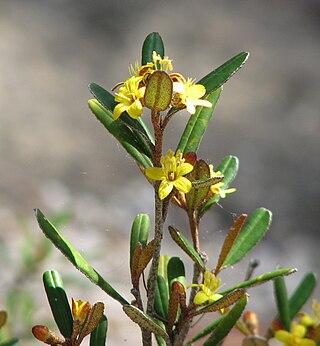
Phebalium whitei is a small shrub that is endemic to south-east Queensland. It has branchlets covered with silvery and rust-coloured scales, leathery, oblong to elliptic leaves and bright yellow flowers arranged in sessile umbels on the ends of branchlets.

Phebalium bullatum, commonly known as silvery phebalium, desert phebalium or sand phebalium, is a species of shrub that is endemic to southern continental Australia. It is more or less covered with silvery scales and has narrow oblong to narrow wedge-shaped leaves and yellow flowers in umbels of about six.

Phebalium stenophyllum, commonly known as narrow-leaved phebalium, is a species of small shrub that is endemic to south-eastern Australia. It has scaly branchlets, narrow oblong to more or less cylindrical leaves and yellow flowers in umbels of three to ten.

Phebalium squamulosum , commonly known as scaly phebalium or forest phebalium, is a species of shrub or slender tree that is endemic to eastern Australia. It has smooth branches covered with rust-coloured scales, linear to elliptical or egg-shaped leaves with the narrower end towards the base, and pale to bright yellow flowers in umbels with rust-coloured or silvery scales on the back.

Philotheca salsolifolia is a species of flowering plant in the family Rutaceae and is endemic to New South Wales and the Australian Capital Territory. It is a shrub with crowded, more or less cylindrical leaves and pink to mauve flowers with a dark central stripe and arranged singly or in twos or threes on the ends of branchlets.
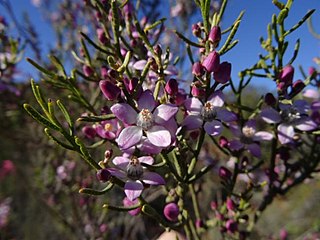
Philotheca brucei is a species of flowering plant in the family Rutaceae and is endemic to Western Australia. It is a shrub with cylindrical leaves grooved along the top and in spring, white to pink or mauve flowers with five egg-shaped petals.
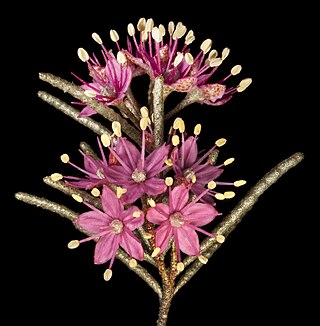
Phebalium canaliculatum is a species of erect shrub that is endemic to the southwest of Western Australia. It is more or less covered with silvery and rust-coloured scales and has thin, cylindrical leaves and dark pink to pale mauve flowers in umbels on the ends of branches.
Phebalium brachycalyx is a species of shrub that is endemic to the southwest of Western Australia. It is more or less covered with silvery and rust-coloured scales, and has narrow oblong leaves with wavy-glandular edges, and white to pale yellow flowers in umbels on the ends of branches.
Phebalium clavatum is a species of shrub that is endemic to Western Australia and is more or less covered with silvery scales. It has warty branchlets, more or less circular leaves with a large spherical gland and white flowers arranged singly on the ends of branchlets.

Phebalium lepidotum is a species of rounded shrub that is endemic to Western Australia. It has scaly branchlets, leathery, narrow oblong leaves and white to cream-coloured flowers arranged in umbels of between three and six on the ends of branchlets.
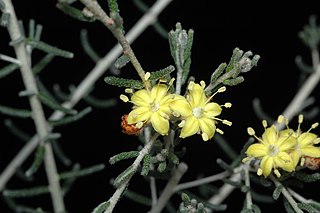
Phebalium lowanense, commonly known as the Lowan phebalium, is a species of slender shrub that is endemic to southern continental Australia. It is more or less covered with silvery and rust-coloured scales and has leaves appearing to be cylindrical, and yellow mauve flowers in umbels on the ends of branches.

Phebalium megaphyllum is a species of erect, rounded shrub that is endemic to Western Australia. It has glandular-warty branchlets, oblong to wedge-shaped leaves with a groove on the upper surface, and white flowers arranged in umbels of three to six on the ends of branchlets.
Phebalium microphyllum is a species of small, rounded shrub that is endemic to Western Australia. It has scaly branchlets, leathery, oblong leaves, and yellow flowers arranged in umbels of three to six on the ends of branchlets.

Phebalium obcordatum, commonly known as the club-leaved phebalium, is a species of shrub that is endemic to New South Wales. It has smooth branchlets, small egg-shaped to heart-shaped leaves with the narrower end towards the base and small umbels of pale yellow flowers with silvery scales on the back of the petals.
Phebalium obovatum is a species of spreading shrub that is endemic to Western Australia. It has thick, egg-shaped or elliptical leaves densely covered with silvery scales on the lower side and white flowers arranged in umbels with silvery or rust-coloured scales on the back.

Phebalium tuberculosum is a species of erect shrub that is endemic to Western Australia. It has glandular-warty and scaly branchlets and leaves and white flowers arranged in umbels of three or four with rust-coloured scales on the back of the petals.

Phebalium verrucosum is a species of shrub that is endemic to New South Wales. It has branchlets densely covered with white scales, narrow elliptic, oblong or linear leaves covered with white scales on the lower side, and umbels of creamy white flowers with silvery or rust-coloured scales on the back of the petals.
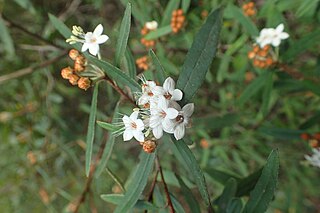
Phebalium woombye, commonly known as wallum phebalium, is a species of shrub that is endemic to eastern Australia. It has branchlets covered with scales and star-shaped hairs, elliptical leaves, and white to pink flowers arranged in umbels of four to ten flowers.

Leionema oldfieldii is a small shrub that is endemic to mountainous locations in Tasmania, Australia. It has dark green leaves, compact pale pink to white flowers from November to January.

Rhadinothamnus euphemiae, is a slender, small, upright shrub with needle-shaped branchlets thickly covered with silvery scales and tubular greenish-purple tubular flowers throughout the year. It is endemic to the south coast of Western Australia.

















